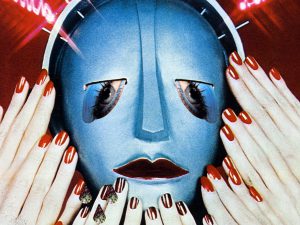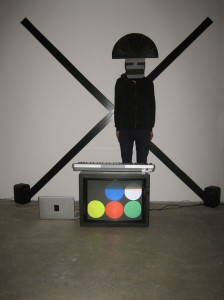‘Cacotopia’: a new exhibition at the Burgess Foundation
-
Laura Mansfield
- 23rd April 2013
-
category
- Blog Posts
Curator Laura Mansfield has been working with the Burgess Foundation to develop an exhibition of contemporary artworks that respond to Anthony Burgess’s idea of ‘cacotopia’. Here is a piece by her on the background to the exhibition, which opens on Thursday 23 May, 6pm-8pm.
———————-
In his discussion of George Orwell’s Nineteen Eighty Four, Anthony Burgess introduces the term ‘cacotopia’, merging the words ‘cacophony’ and ‘utopia’. Abandoning the more common expression ‘dystopia’ Burgess uses the word cacotopia in order to more strongly describe a government of the very worst kind. As societies imagined on the lines of cacophony or cacodemon, cacotopias evoke extreme states of political disharmony and social dissonance. In contrast to the harmonious rhythms and orders of good government, the words refers to a kind of forced order of disunity. For Burgess it is such discordance, the dictation of a norm that suppresses its underlying conflicts, that forms the setting for Orwell’s Nineteen Eighty Four, as well as his own cacotopian visions that he developed in the novels 1985 and The Wanting Seed.

In Burgess’s discussion of Nineteen Eighty Four he goes on to suggest that a cacotopian tendency of society is visible in his lifetime. When ‘the stresses of contemporary life grow intolerable’ we can read the signs for a coming cacotopia: ‘There are bills to pay, machines that go wrong and cannot be repaired, roofs that leak, buses that fail to arrive, dull work to be done, an inability to make ends meet, insurance premiums that fall due, sickness, the panorama of the wicked world displayed in the press…’
Mirroring Burgess’s vision of a mundane everyday as an index for a cacotopian future, the forthcoming exhibition highlights a discord between present, everyday rationality and the potential chaos, oppression and violence such rationality holds and seeks to suppress. Including a selection of new and existing works from artists Matti Isan Blind, Franziska Lantz, Rebecca Lennon, Elisabeth Molin, Heather & Ivan Morison and David Wojtowycz, the exhibition presents a series of responses to the idea of cacotopia. Each artwork is rooted in a familiar aspect of the everyday, from the mass of advertising imagery to the omnipresence of the television screen and the abundance of domestic paraphernalia. Such objects and images become the material base for cacotopian fictions. Installed within the Burgess Foundation archive, amongst items of Burgess’s furniture, typewriters and photographs the exhibition becomes an installation, transforming the site into a space of unsettling discord.
Artist and musican Franziska Lantz has developed a sound work to be installed on the staircase leading down to the exhibition space. Echoing down the staircase to the installed exhibition works the sound track will frame the audience’s journey inviting them into a cacotopian future. The exhibition will open on May 23 with Lantz performing her cacotopian sound track live in the events space. Working as both musician and artist Lantz is known for her unique performances. Between 2008-2012 she produced the weekly Radio programme ‘DriftShift’ on London’s ResonanceFM, using found sounds and texts. Most recently she developed a performance work for the Henry Moore Institute, Leeds as part of the exhibition Government by Michael Dean. In developing her work for the Cacotopia exhibition Lantz has been making field recordings in an abandoned Hackney hospital, taking the echo of surgical metals and titled scrub rooms as the baseline for her cacotopian soundtrack.

Accompanying the exhibition, there is a series of artist’s films to be screened on May25 at 6.30pm. Each of the programmed films subvert the everyday through structures of repetition and interruption, from a technological disruption of the projection screen, to representations of disconnected filmic landscapes and juxtaposed fragments of destructive imagery infused with subversive melancholia. Such disruptions serve to transform familiar imagery into moments of cacotopian dissonance. Artists contributing to the programme include Ulf Aminde, Matti Isan Blind, Aline Bouvy & John Gillis, Rebecca Lennon, Jen Lui, and David Wojtowycz.
Throughout the development of the exhibition we have been working with illustration students at Salford University to devise a series of posters that respond to the cacotopian theme. The posters will be on display in the Engine House cafe. With the posters, the opening performance, exhibition installation and an evening programme of films we hope to infuse the Burgess Foundation with a visual and acoustic array of cacotopian fictions.


